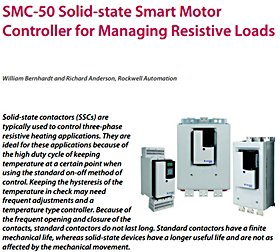A lot of resistive load applications use solid-state contactors or in some cases, properly sized standard contactors to perform the control.
The downfall of standard contactors is the duty cycle wear and tear of the contactor itself. Electro-mechanical components have a finite duty life cycle compared with solid-state devices that have a much longer life due to little or no mechanical parts.
To keep a process at a certain temperature, some type of control is be needed to cycle the contactors on and off.
That control could come from a programmable logic controller (PLC), temperature single loop controller or something in between.
Standard silicon-controlled rectifiers (SCRs) will generally use a form of control known as zero cross, basically turning on and off at the zero cross of the sine wave.
The on-and-off function could be for one cycle or could sometimes use a zero cross time base function. Time base function has the SCRs fire for "x" time, and then off for "y" time, then repeat, as shown in the figure below.


